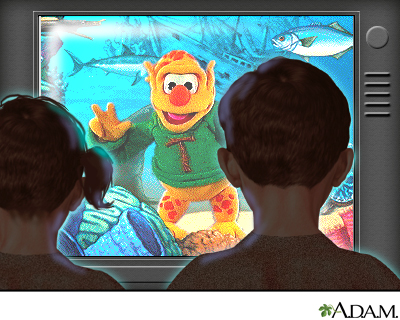Screen time and children
Images

Description
"Screen time" is a term used for activities done in front of a screen, such as watching TV, working on a computer, or playing video games. Screen time is a sedentary activity, meaning you are being physically inactive while sitting down. Very little energy is used during screen time.
Most American children spend about 3 hours a day watching TV. Added together, all types of screen time can total 5 to 7 hours a day.
Too much screen time can:
- Make it hard for your child to sleep at night
- Raise your child's risk for attention problems, anxiety, and depression
- Raise your child's risk for gaining too much weight (obesity)
Screen time increases your child's risk for obesity because:
- Sitting and watching a screen is time that is not spent being physically active.
- TV commercials and other screen ads can lead to unhealthy food choices. Most of the time, the foods in ads that are aimed at kids are high in sugar, salt, or fats.
- Children eat more when they are watching TV, especially if they see ads for food.
Computers can help kids with their schoolwork. But surfing the internet, spending too much time on social media, or watching YouTube or Tik-Tok videos is considered unhealthy screen time.
Current Screen Time Guidelines
Children under age 2 should have no screen time.
Limit screen time to 1 to 2 hours a day for children age 2 and over.
Despite what ads may say, videos that are aimed at very young children do not improve their development.
How to Decrease Screen Time
Cutting down to 2 hours a day can be hard for some children because TV may be such a large part of their daily routines. But you can help your children by telling them how sedentary activities affect their overall health. Talk to them about things they can do to be healthier.
To decrease screen time:
- Remove the TV or computer from your child's bedroom.
- Do not allow TV watching during meals or homework.
- Do not let your child eat while watching TV or using the computer.
- Do not leave the TV on for background noise. Turn on the radio instead, or have no background noise.
- Decide which programs to watch ahead of time. Turn off the TV when those programs are over.
- Suggest other activities, such as family board games, puzzles, or going for a walk.
- Keep a record of how much time is spent in front of a screen. Try to spend the same amount of time being active.
- Be a good role model as a parent. Decrease your own screen time to 2 hours a day.
- If it is hard not having the TV on, try using a sleep function so it turns off automatically.
- Challenge your family to go 1 week without watching TV or doing other screen-time activities. Find things to do with your time that get you moving and burning energy.
Related Information
References
American Psychological Association. Health advisory on social media use in adolescence. www.apa.org/topics/social-media-internet/health-advisory-adolescent-social-media-use. Accessed April 30, 2025.
Baum RA, Schilling S. Positive parenting and support. In: Kliegman RM, St. Geme JW, Blum NJ, et al, eds. Nelson Textbook of Pediatrics. 22nd ed. Philadelphia, PA: Elsevier; 2025:chap 20.
Gahagan S. Overweight and obesity. In: Kliegman RM, St. Geme JW, Blum NJ, et al, eds. Nelson Textbook of Pediatrics. 22nd ed. Philadelphia, PA: Elsevier; 2025:chap 65.
Lissak G. Adverse physiological and psychological effects of screen time on children and adolescents: Literature review and case study. Environ Res. 2018;164:149-157. PMID: 29499467 pubmed.ncbi.nlm.nih.gov/29499467/.
BACK TO TOPReview Date: 4/5/2025
Reviewed By: Charles I. Schwartz, MD, FAAP, Clinical Assistant Professor of Pediatrics, Perelman School of Medicine at the University of Pennsylvania, General Pediatrician at PennCare for Kids, Phoenixville, PA. Also reviewed by David C. Dugdale, MD, Medical Director, Brenda Conaway, Editorial Director, and the A.D.A.M. Editorial team.

Health Content Provider
06/01/2028
|
A.D.A.M., Inc. is certified by URAC, for Health Content Provider (www.urac.org). URAC's certification program is an independent audit to verify that A.D.A.M. follows rigorous standards of quality and accountability. A.D.A.M. is among the first to achieve this important distinction for online health information and services. Learn more about A.D.A.M.'s editorial policy, editorial process and privacy policy. |
The information provided herein should not be used during any medical emergency or for the diagnosis or treatment of any medical condition. A licensed medical professional should be consulted for diagnosis and treatment of any and all medical conditions. Links to other sites are provided for information only -- they do not constitute endorsements of those other sites. © 1997- 2025 A.D.A.M., a business unit of Ebix, Inc. Any duplication or distribution of the information contained herein is strictly prohibited.
